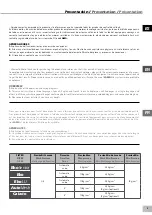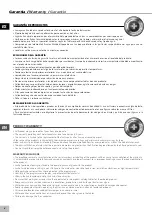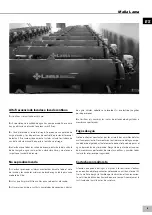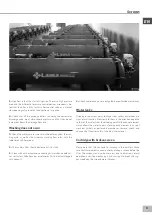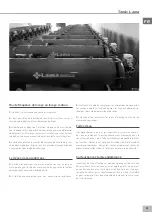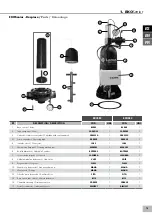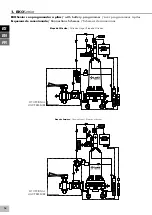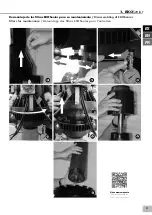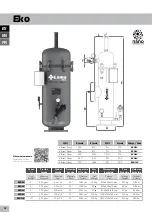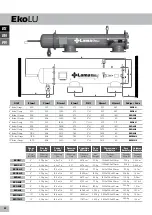
manual).
• Due to excess impurities in the water. Lowering the flow rate
is recommended until the ducts are clean. After a reasonable
amount of time, the flow rate can be increased gradually.
• Check that the differential pressure is suitable.
• Because washing is not being completed successfully, due to
the short duration of the washing or low pressure during was-
hing (see minimum required time, pressure, flow rate, and pollu-
tants parameters for each model).
4.- Washing does not occur and there is a loss of pressure.
Check that the base plugs are connected to the solenoids and that
the safety screws are tight. Check that the stopcock controlling the
supply to the auxiliary filter is open.
It may be that the pressure connections to the sensors or to the
pressure switch are wrong or badly adjusted. The three-way valves
or solenoids can be in an incorrect manual position.
5.- Problems with the suction devices.
If there are water leaks when pressure is first applied or an object
is introduced in the closure, close the optional shut-off valve and/
or eliminate the pressure before disassembling by unscrewing the
base. Clean it, screw it back on, and open the air valve.
Starting up after a long shutdown period
1.-
Start the system up and slowly increase pressure. Complete two
or three washing cycles in a row. Check that the maximum pressure
supported by the system is not surpassed.
2.-
The controller has a partial counter for the number of washing
cycles (depending on the model). If you set it to zero, save the
number of cycles. There are controllers which keep a total count.
3.-
It is recommended to change the seals and membranes or dia-
phragms every 14,000 cycles.
4.-
Clean the solenoids if the drainage microtubes marked in yellow
no longer drain.
5.-
Disassemble and check the cartridge (follow the instructions
and photographs of each filter) and possible obstructions caused
by sand stuck in the screen, iron or lime deposits. Clean manually
and, if necessary, with acid.
6.-
Exchange manometers or replace them with new ones.
7.-
Clean auxiliary filter of the hydraulic control circuit.
High frequency of washing or continuous washing
1.-
Check if the cartridge is dirty.
2.-
It is possible that the quality of the water has gotten worse. In
that case the flow rate should be reduced, or more filters installed.
Screen
Operation
1.-
Depending on the model, the equipment may come with some
components or elements not assembled in order to make transpor-
tation easier and safer, which then have to be assembled.
2.-
There are various filter models and various controller models.
Check that the one you received corresponds to the one you orde-
red or with the standard model. Each model has specific flow rates
and voltages.
3.-
Place the filters in ventilated areas and on a flat surface, with a
natural drainage path to the external drain and keeping minimum
distances to walls and ceilings in order to have easy access to ma-
nually disassemble the cartridges.
4.-
Fasten or screw in the inlet and outlet connections. Make sure
that they are not subject to vibration or extreme thermal expan-
sion. Place the models Eko, Calado, and EkoSenior vertically on
their legs (optional); the Automesh and EKOLU models should be
placed horizontally. In any case, they should be fastened to their
flanged connections rigidly enough to support the weight.
5.-
When the system is made up of more than one filter, only one
controller is usually used (see controller manual).
6.- Please, check the ferrule frequently. It is the numbers 20 and
6 item from the spare part at the page 21 and 23. It belongs to the
EKO and EKOLU filters.
7.-
The working pressures of this equipment have been tested at
23º C in standard conditions. The use of the equipment in extreme
temperatures is not recommended, please contact us for further
questions.
Fault locator
1.- Water leaking from the drains of the Globo cleaning valves or
other valves.
Wait until the system pressure is at least 1kg/cm² and, if necessary,
increase the pressure or flow rate to reach this minimum pressure
level. When the flow rate or pressure is low, sometimes it is ne-
cessary to install stabilising valves at the outlet of the system to
increase the pressure.
2.- Significant loss of pressure when starting to fill the pipes.
When there is an excess flow rate due to low pressure in the pipes,
a manual valve should be installed and closed off. Alternatively, a
system with an intelligent controller and a stabilising valve can be
used. After some time and once the piping system is full, the los-
ses should match the flow rate and values given in the tables. The
switchboards have a system in place for delaying the start of the
washing cycle to avoid this situation.
3.- Repeated backwashing. This can appear for different reasons:
• Due to a significant pressure drop (see previous point).
• Short delay time for starting the washing cycle (see controller
EN
10



